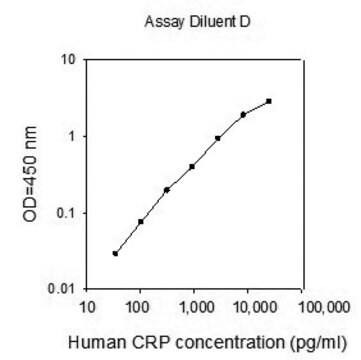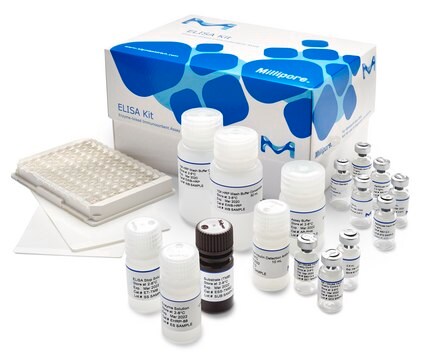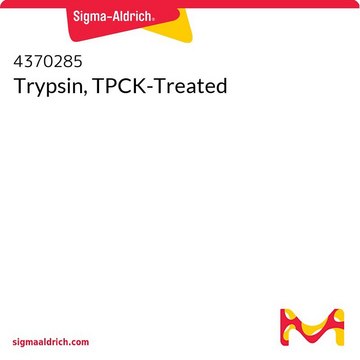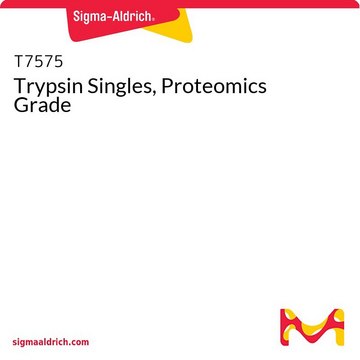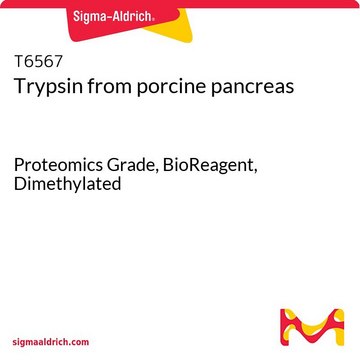4352135
iTRAQ® Reagents Multiplex Kit
Sinônimo(s):
isobaric tags for relative and absolute quantitation
Faça loginpara ver os preços organizacionais e de contrato
About This Item
Código UNSPSC:
12161503
NACRES:
NA.24
Produtos recomendados
Descrição geral
Contains iTRAQ® reagents 114, 115, 116, 117, the appropriate buffers and reagents for ten 2-plex, six 3-plex, or five 4-plex assays. 10-PK trypsin is sold separately. Each individual reagent is capable of labeling up to 100 μg of protein.
Aplicação
The iTRAQ® Reagents Multiplex Kit provides iTRAQ® reagents and protocol to label peptides after digestion. This widely used generic labeling kit can be used for virtually any workflow.
iTRAQ® Reagents Multiplex Kit has been used for the labeling of peptides for LC-MS (liquid chromatography–mass spectrometry)/MS analysis.
iTRAQ® Reagents Multiplex Kit has been used for the labeling of peptides for LC-MS (liquid chromatography–mass spectrometry)/MS analysis.
Nota de análise
To view the general Protocol for iTRAQ Reagents, please visit this Protocol link.
To view the Chemistry Quick Reference Card for the iTRAQ Reagents, please visit this Chemistry Quick Reference Card link.
The Certificate of Analysis (CofA) for your specific lot is accessible by entering the product number and lot number at this CofA access link.
To view the Chemistry Quick Reference Card for the iTRAQ Reagents, please visit this Chemistry Quick Reference Card link.
The Certificate of Analysis (CofA) for your specific lot is accessible by entering the product number and lot number at this CofA access link.
Informações legais
iTraq is a registered trademark of AB Sciex Pte. Ltd.
Palavra indicadora
Danger
Frases de perigo
Declarações de precaução
Classificações de perigo
Acute Tox. 4 Dermal - Acute Tox. 4 Inhalation - Acute Tox. 4 Oral - Eye Irrit. 2 - Flam. Liq. 2 - Skin Irrit. 2 - STOT SE 3
Órgãos-alvo
Central nervous system
Código de classe de armazenamento
3 - Flammable liquids
Ponto de fulgor (°F)
35.6 °F - closed cup
Ponto de fulgor (°C)
2.0 °C - closed cup
Escolha uma das versões mais recentes:
Já possui este produto?
Encontre a documentação dos produtos que você adquiriu recentemente na biblioteca de documentos.
Os clientes também visualizaram
Sonia Osorio et al.
Plant physiology, 157(1), 405-425 (2011-07-29)
Tomato (Solanum lycopersicum) is an established model to study fleshy fruit development and ripening. Tomato ripening is regulated independently and cooperatively by ethylene and transcription factors, including nonripening (NOR) and ripening-inhibitor (RIN). Mutations of NOR, RIN, and the ethylene receptor
Quantitative proteomic approach to study subcellular localization of membrane proteins.
Sadowski PG, et al.
Nature Protocols, 1, 1778-1789 (2006)
Izhak Michaelevski et al.
Molecular & cellular proteomics : MCP, 9(5), 976-987 (2009-12-04)
Investigations of the molecular mechanisms underlying responses to nerve injury have highlighted the importance of axonal transport systems. To obtain a comprehensive view of the protein ensembles associated with axonal transport in injured axons, we analyzed the protein compositions of
Emilie Ernoult et al.
Proteome science, 6, 27-27 (2008-10-15)
The development of mass spectrometric techniques and fractionation methods now allows the investigation of very complex protein mixtures ranging from subcellular structures to tissues. Nevertheless, this work is particularly difficult due to the wide dynamic range of protein concentration in
Comparative Analysis of Secretome Profiles of Manganese(II)-Oxidizing Ascomycete Fungi.
Zeiner CA, et al.
PLoS ONE, 11, e0157844-e0157844 (2016)
Nossa equipe de cientistas tem experiência em todas as áreas de pesquisa, incluindo Life Sciences, ciência de materiais, síntese química, cromatografia, química analítica e muitas outras.
Entre em contato com a assistência técnica


